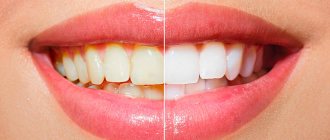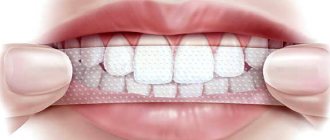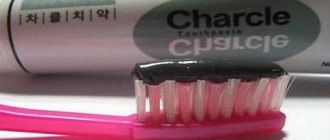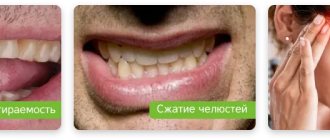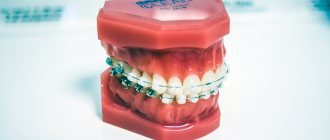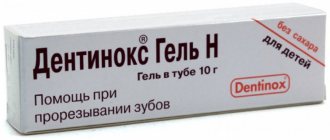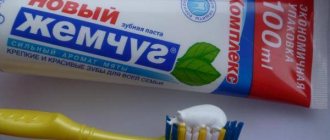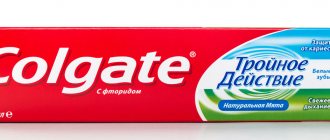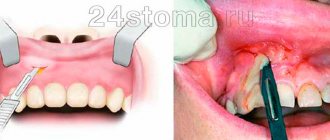From this article you will learn:
- why do white spots appear on teeth,
- how quickly do they occur in children,
- what is enamel demineralization,
- how to treat initial caries in the spot stage.
White spots on teeth most often indicate the initial stage of caries, which is manifested by the appearance of foci of demineralization on the surface of the enamel. Foci of enamel demineralization occur in response to excessive exposure to organic acids that produce cariogenic bacteria in the oral cavity. If you do not brush your teeth immediately after eating, bacteria begin to “digest” carbohydrates, turning them into acid. The production of acid leads to a decrease in the pH of the oral fluid (in other words, to an increase in its acidity).
As soon as the pH of the oral fluid drops below 5.5, the dissolution of the surface layers of enamel begins. As a result, tooth enamel begins to lose minerals - calcium and phosphates, which leads to a decrease in its mineralization. The surface of areas of demineralization has the appearance of white chalky spots, which can have slightly different colors - from slightly matte to bright white. In dentistry (to denote this initial stage of the carious process) the term “caries in the white spot stage” is used.
What caries looks like in the spot stage: photo
White spots on teeth have typical localization locations - these are the visible surfaces of the front and side teeth (the necks of the teeth are most often affected, since this is where plaque accumulates). The surface of the enamel in areas of demineralization is rough and lacks the shine characteristic of healthy enamel. The top layer of demineralized enamel is very fragile and can be easily scraped off with a sharp instrument. But until demineralization reaches a critical level, and the organic enamel matrix is preserved, a carious defect does not form.
Important: it is worth distinguishing initial caries in the white spot stage from white spots of non-carious origin that occur with enamel hypoplasia and fluorosis. But this can be easily checked - you need to apply a dye (1-2% solution of methylene blue), which is available in any pharmacy, to the surface of the stains. Foci of demineralization will temporarily turn blue, but with hypoplasia and fluorosis, staining of the spots does not occur, because The enamel in these diseases is very dense.
An interesting point is that with initial caries in the spot stage, the most significant changes do not occur on the surface of the enamel, but in its subsurface layers. The surface layer of enamel, on the contrary, is still in a relatively satisfactory condition. This is due to the migration of calcium and phosphates from the subsurface layer, and on the other hand, with the possibility of the entry of mineral components from oral fluid (saliva).
Initial caries in the spot stage - causes
As you already understand, the main reason is soft microbial plaque and food debris in the oral cavity. Remember that after eating it is not enough to simply rinse your mouth and chew gum, and the most important thing is to remove food debris from the interdental spaces using dental floss. If you don't brush your teeth after every meal, if you don't floss regularly, if you overindulge in snacks and sugary drinks between meals, all of this will lead to demineralization of your tooth enamel.
Moreover, white spots on a child’s teeth occur much more easily than in adults. This is due to the fact that the enamel of children’s teeth (both milk and permanent) is initially low-mineralized. And therefore, in children, insufficient oral hygiene, as well as sugary drinks and frequent snacks between meals, lead to the development of caries in the white spot stage much faster.
Accumulations of microbial plaque and tartar at the necks of teeth -
In photos 3-5, please note that soft microbial plaque and tartar are primarily always localized in the area of the necks of the teeth. If dental plaque is removed from such patients, we will almost certainly immediately see foci of demineralization hidden under plaque. Moreover, white chalky spots become better visible when the tooth enamel is slightly dried (for example, with a stream of air).
How quickly can white spots appear on teeth - according to the guide for doctors “Caries: Prevention, New Treatment Methods and Remineralization” (edited by Fleischer G.M.) - with deteriorating oral hygiene and frequent consumption of carbohydrates between meals (snacks, cookies , candies, sweet drinks, etc.) focal demineralization of the enamel can occur within 3-4 weeks. But in this case we are talking about well-mineralized permanent teeth. Therefore, if we talk about children, white spots on a child’s teeth (deciduous or permanent) can form in a shorter period of time.
Areas of prevention
A large number of dental diseases develop due to insufficient oral hygiene. If you regularly brush your teeth and use additional products (rinses, tongue brushes, etc.), you can significantly reduce the risk of not only caries, but also gingivitis, periodontitis and many other dangerous diseases. Hygiene alone is not enough to guarantee absolute dental health. In addition, the onset of caries is very difficult to recognize due to the absence of any symptoms. Therefore, it is important to regularly visit the dentist for preventive purposes. The specialist will conduct a visual diagnosis and will be able to identify the early onset of caries and cure it quickly and easily. One visit every six months is considered optimal; it can be combined with professional teeth cleaning, which will also help reduce possible risks.
If the white spots of caries are already noticeable, then you should not wait until the situation worsens. Without professional help, the disease will not disappear, but will only progress. And if the superficial process is eliminated by conservative treatment methods, then with a deeper spread it will be necessary to install fillings, and in the most severe cases, remove teeth and install dentures.
You should trust the health of your teeth only to experienced specialists who have at hand all the necessary equipment to diagnose all possible dental diseases, as well as high-quality materials with which they can restore the former whiteness of your smile.
Caries in the spot stage: treatment
Treatment of initial caries in the spot stage is carried out conservatively. Because The process of formation of white spots is associated with focal demineralization of tooth enamel (washing out calcium, fluorine and phosphates from it), then we must again saturate the enamel with these microelements. The method of saturating tooth enamel with lost microelements is called “teeth remineralization.”
But there is one important point here. You must understand that the formation of “white caries” does not occur on its own, but due to poor oral hygiene (24stoma.ru). And if the current level of hygiene does not improve, then remineralization of teeth will either not lead to the disappearance of foci of demineralization, or its effect will be insufficient. Therefore, an important role in treatment belongs to your motivation and willingness to pay much more attention to your teeth.
A course of dental remineralization can be home or professional. Remineralization of teeth at the dentist is usually carried out with preparations with a high concentration of fluoride (usually 5% sodium fluoride). As you will see below, highly concentrated fluoride is not the optimal treatment solution for white spots on teeth, although it may lead to a slight reduction in the size of the spots. And below we will explain what this is connected with.
What results can you expect from white spot treatment? –
The effectiveness of tooth remineralization in the treatment of caries in the white spot stage depends on two criteria: 1) the clinical size of the white spot, 2) the level of permeability for the dye. Small white spots measuring up to 3.0-5.0 mm2 inclusive, demonstrating a low degree of dye permeability (1% methylene blue) are usually quite easily reversed. In this case, we can expect their complete disappearance as a result of remineralizing therapy + normalization of hygiene.
But with white spots that demonstrate a high degree of dye permeability, as well as white spots larger than 5.0 mm2 (they can reach sizes up to 28-30 mm2), the situation is completely different. In most cases, you can only count on a reduction in their size, as well as a decrease in their visibility due to a decrease in brightness and restoration of the shine of the enamel. There is a strict dependence: the larger the size of the spot, the less likely it is that it will disappear completely. But in the absence of treatment, with a high probability, carious cavities will form over time at the site of foci of demineralization.
The level of permeability of white spots for dye is determined by conducting a test according to Okushko V.R. (also called the enamel resistance test or TER test). Sensitivity to the dye is determined by a 1% solution of methylene blue. The results are interpreted based on the color intensity of the white spots, using a 10-point blue scale. If the color corresponds to 1-3 points, then there is a high probability that the white spots will completely disappear after remineralizing therapy. When coloring scores 6 or more, you can only count on reducing the size and improving the appearance of the spots.
Thus, the effectiveness of remineralization will be indicated by the complete disappearance of white spots, a reduction in their size, as well as an improvement in their appearance (they should become less noticeable). A simple stabilization of the number and size of white spots will also indicate little effectiveness. If there is no initial caries at the spot stage, the effectiveness of enamel remineralization can be judged by the decrease in the frequency of appearance of new caries lesions (compared to previous periods).
1) Professional products for remineralization –
Starting with a visit to the dentist would be the right decision, because if you have dental plaque, you first need to have your teeth professionally cleaned. Next, the dentist usually suggests treating the teeth with a remineralizing varnish or gel with a high fluoride content (for example, 5% sodium fluoride). The problem is that such remedies will not only be ineffective in eliminating foci of demineralization in the form of white spots, but can also spoil all subsequent treatment if you plan to get rid of the spots in full.
We have already said above that when caries develops in the white spot stage, it is not the enamel surface that undergoes the most severe demineralization, but rather its subsurface layers. The surface layer of the demineralization focus (in the area of the white spot) gradually becomes much denser, and quite a lot of fluorapatite is found in it. The formation of such a well-mineralized “crust” on the surface of the white spot occurs due to several parallel processes.
Firstly, this is a consequence of a protective mechanism due to which minerals migrate from the subsurface layers of enamel to the surface of the demineralization site. The purpose of this defense mechanism is to try to protect the white spot from ongoing "acid attacks" and its development into a carious defect. The second reason lies in the use of products with fluoride against the background of ongoing acid attacks (fluorides against the background of low pH of the oral fluid lead to the formation of fluorapatites in the surface layer of the white spot).
High fluoride content on the surface of the white spot –
Important: thus, if at the very beginning of white spot therapy we immediately treat the teeth with varnish or gel with a high dosage of fluoride (or we use toothpastes with a high dosage of fluoride), this will lead to the creation of white spots on the surface - dense and durable mineral layer with a high concentration of fluorapatite and fluorohydroxyapatite. In the future, this layer will only impede the penetration of calcium and phosphates into the site of demineralization. Although it must be admitted that after such treatment, the size of the white spots may initially decrease slightly.
Therefore, at stage 1, it is undesirable to use professional varnishes and gels for remineralizing teeth containing high concentrations of fluorides. But if the ultimate goal of remineralization is to strengthen teeth and reduce the risk of caries, then such products would be a good choice. For example, this is Colgate Duraphat fluoride varnish with 5% sodium fluoride. This is a fluoride varnish “MI Varnish” - with 5% sodium fluoride and the CPP-ACP complex. This is Clinpro White Varnish - with 5% sodium fluoride and tricalcium phosphate. These are excellent products specifically for strengthening teeth and preventing caries, but not for treating white spots.
Preparations for remineralization of enamel (for the purpose of caries prevention) –
Therefore, if you want to remove white spots on your teeth (striving for the best possible result), you need to start remineralization not with high concentrations of fluoride, but with the Recaldent® complex. This name hides “amorphous calcium phosphate associated with casein phosphopeptides” (abbreviated as CPP-ACP). These are the products “GC Tooth Mousse” and “GC MI Paste Plus”, which are produced - well known among dentists all over the world. These are professional products that can also be used at home, and we will discuss them in detail below.
Electrophoresis of a calcium gluconate solution - by the way, if for various reasons you are having your teeth treated in a public dental clinic, then you can also ask your dentist to give you a referral to a physiotherapy room for electrophoresis of a calcium gluconate solution or calcium glycerophosphate (a course of 10 procedures). This method will also moderately remineralize tooth enamel. But let’s say right away that buying and rubbing tablets with calcium gluconate into tooth enamel will be a completely useless exercise, because... dissociation of calcium gluconate with the release of active calcium ions is possible only through electrophoresis. But after a course of electrophoresis, it would be logical to carry out several dental fluoridation procedures.
2) The best products for self-use -
Dental gels “GC Tooth Mousse” and “GC MI Paste Plus” are recognized by most dentists around the world as the standard for remineralizing therapy for initial caries (in the white spot stage).
But these drugs not only help you fight white spots on your teeth; for example, they will also allow you to significantly reduce the risk of developing caries. But there is a problem with effective white spot remineralization therapy regimens - an inconvenient treatment regimen. Only a course of treatment can be effective - the guideline is 1 month. Moreover, if you do daily procedures 2 times a day (morning and evening - after meals and oral hygiene), it will be more effective than with a single procedure per day. And such long courses mean that you will not be able to go to the dentist in this mode. Small white spots may disappear in a shorter period of time, and in some cases repeated courses of therapy may be required.
The best drugs for the treatment of caries in the white spot stage -
The GC Tooth Mousse and GC MI Paste Plus gels are very easy to use and can be applied to the teeth with your index finger. Unlike many other remineralizing gels, they absolutely do not require the use of dental trays (so that saliva does not reduce the concentration of the gel on the teeth). On the contrary, saliva is necessary for the CPP-ACP complex to form a thick layer of amorphous calcium phosphate on the teeth. Application of the gel lasts from 3 to 5 minutes, during which you should not spit saliva. But after this you can spit out the saliva, and for half an hour you will not be able to eat, drink or rinse your mouth with water. It's simple.
Ingredients : GC Tooth Mousse – contains 10% CPP-ACP (for use in adults and children from 1 year). Gel “GC MI Paste Plus” - contains 10% CPP-ACP + 900 ppm sodium fluoride, and therefore it is used at home only from 12 years of age.
According to research, the effectiveness of the second gel is 15% higher, and therefore, first of all, we recommend it. A low concentration of fluoride in the presence of CPP-ACP stimulates the phase transformations of amorphous calcium phosphate on the enamel surface, as well as the penetration of calcium and phosphate ions into the depths of the demineralization site. Therefore, low dosages of fluoride in the treatment of white spots can, on the contrary, be useful, but only in the presence of a source of calcium and phosphates (which is CPP-ACP).
Important: numerous studies indicate that fluoride ions can not only protect teeth from the development of caries. In the presence of calcium and phosphates, fluoride ions act as a catalyst for the growth of enamel hydroxyapatite crystals, and also ensure remineralization of enamel even at a more acidic pH of 4.5-5.5 (at which demineralization of enamel always occurs under normal conditions). That is why, if you have white spots on your teeth, you should choose products that simultaneously contain both sources of calcium and phosphates, as well as moderate dosages of fluorides.
There are other medications available to remineralize white spots, but they will not be as effective. These include preparations based on calcium glycerophosphate (for example, the inexpensive and popular ROCS minerals gel), brushite (RemarsGel) and some others. Read more about such drugs at the link below.
→ Remineralizing gels “ROCS” and RemarsGel
White spot therapy for the lazy –
If you are not going to spend a lot of time and effort to get rid of white spots, then you can offer several options. If there are only small white spots on your teeth (no more than 3.0 mm2 in size), then in principle they can completely disappear even with such a truncated therapy. But in this case you definitely shouldn’t count on the disappearance of large spots - at most only a reduction in size and a decrease in visibility.
But keep in mind that to achieve the effect, you will in any case have to give up consuming carbohydrates and sugary drinks between meals. Start using dental floss regularly (after every meal), and brush your teeth with a brush and toothpaste 3 times a day, i.e. after every meal. So, what funds can we count on:
APADENT Total Care toothpaste –
In the photo you can see a tube of APADENT Total Care toothpaste (Japan) that I bought. This unique toothpaste was developed for astronauts, and it is produced under license from the NASA space agency. The uniqueness lies in the fact that it contains nano-hydroxyapatite particles ranging in size from only 8 to 40 nm (nanometers), i.e. This is the toothpaste with the smallest nano-hydroxyapatite particle size in the world. But why is this important, and how will it help us against blind spots?
The enamel of our teeth consists of structural formations called enamel prisms, the distance between which is 50 nanometers. Both the enamel prisms and the interprismatic space are made of predominantly hydroxyapatite, but the interprismatic space is less mineralized. This means that when organic acids act on tooth enamel, it is the interprismatic substance that will dissolve, which leads to the appearance of foci of demineralization of tooth enamel (white spots).
Apadent series toothpastes contain nano-hydroxyapatite particles ranging in size from 8 to 40 nm (nanometers), which is less than the distance even between enamel prisms. This leads to the fact that nano-hydroxyapatite particles of this size will penetrate immediately into the depths of the enamel - right inside the foci of demineralization. Any other particles of nano-hydroxyapatite (more than 50 nanometers in size) will form a layer on the surface of the enamel, and therefore their effect will no longer be the same.
Scientific study “Evaluation of the effectiveness of long-term use of Apadent Total Care toothpaste containing medical nano-hydroxyapatite” (authors Makeeva, Polyakova, etc.) the use of Apadent toothpaste with nHAP particles from 8 to 40 nm led to complete remineralization of artificially created foci of demineralization enamel in just 3 days. Those. The paste has a good remineralizing effect, but it is certainly not possible to achieve the disappearance of white spots in such a short time. Adults and teenagers over 12 years of age – use a 1.5 cm strip of toothpaste to brush your teeth.
The duration of brushing your teeth is at least 3 minutes, and we recommend that after brushing you do not immediately spit out the toothpaste, but hold it in your mouth for another 1-2 minutes. After you spit out the paste, there is no need to rinse your mouth with water. The optimal course duration is 3 months, and the dynamics of the disappearance of spots will depend on their size and the degree of demineralization inside the lesion. For children from 0 to 6 years old there is a similar toothpaste “Apadent Kids”. Let’s say right away that these are expensive toothpastes (a 60 g tube will cost 1,500 rubles, a large 120 g tube will cost about 2,400 rubles), and beware of fakes.
2) Fluoride varnish “MI Varnish” –
If you are not ready to apply remineralizing gel 1-2 times a day (for 1 month or more), then MI Varnish fluoride varnish can serve as a good alternative. At least one procedure, but best of all is a course of 2-3 procedures with an interval of several days. Optimally, apply immediately after professional oral hygiene at the dentist.
3) Fluoride varnish “Clinpro White Varnish” –
Clinpro White Varnish Fluoride Varnish – Contains a combination of 5% sodium fluoride and protected tricalcium phosphate. The latter is a source of calcium and phosphates for demineralized enamel, but we honestly admit that tricalcium phosphate is still inferior to the CPP-ACP complex (if we compare their remineralizing ability). Therefore, if your dentist can offer you “MI Varnish”, that’s great, and if only “Clinpro White Varnish”, then you should also agree.
Well, after such treatment, you need to use toothpaste with an intense remineralizing effect for several months. It must be said that we usually recommend the application of MI Varnish or Clinpro White Varnish as a procedure that completes the course of application of GC Tooth Mousse, GC MI Paste Plus, or, at worst, ROCS medical gels minerals". But for lazy or too busy people who are unable to endure more than one trip to the dentist, these products will be a good alternative.
4) Enamel-sealing liquid “Tiefenfluorid” –
This drug is for deep fluoridation of teeth, which consists of two components intended for sequential application to the enamel. The first bottle contains: anhydrous magnesium fluoride silicate, anhydrous copper-II fluoride silicate, and sodium fluoride. The second bottle contains highly dispersed calcium hydroxide. When applied sequentially, very small particles of calcium fluoride are formed (about 10 nanometers).
Due to this particle size, they are able to penetrate in large quantities immediately into the depths of demineralization foci. In the depths of these lesions, they will be located in a thixotropic silicic acid gel environment, which will protect them from being washed out (due to this, they remain inside the enamel from 6 months to 2 years). In this case, the particles will constantly release fluoride and calcium ions in a concentration sufficient for remineralization. Typically, a course of 2-3 procedures (with an interval of 7-10 days) is used to treat white spots. After treatment, it is better to use a course of either APADENT Total Care toothpaste or Biorepair PLUS Total Protection.
Important: we have already said above that immediately after professional oral hygiene (for example, ultrasonic teeth cleaning), it is very important to teach the patient proper oral hygiene, and also talk about the importance of brushing teeth after every meal. Believe me, just proper regular hygiene, as well as avoiding the consumption of carbohydrates between meals, is already about 50% of success. Those. small white spots that show low permeability to the dye - these are likely to disappear just as a result of improving your hygiene.
Tooth granuloma: symptoms
The diagnosis of “apical granuloma of the tooth” can only be made by an x-ray, on which a slight rounded darkening will be visible at the apex of the tooth root (Fig. 1). Darkening at the apex of the tooth root on an x-ray always indicates the presence of a chronic focus of inflammation and the presence of bone tissue resorption. As for the patient's complaints and other symptoms, in most cases they are not pronounced or may even be absent.
Most of the time, the tooth may not bother you at all, or periodically there may be pain when biting on the tooth or aching pain from hot foods. Those. These symptoms are standard symptoms of chronic apical periodontitis, one of the forms of which is tooth root granuloma. However, periodically (during periods of decreased immunity) an exacerbation of chronic, low-grade inflammation may occur.
An exacerbation is usually accompanied by acute pain, especially pronounced when biting on a tooth. In addition, the gums in the projection of the root apex may swell at such moments and be painful when touched. An exacerbation of the process may spontaneously subside (return to a chronic course), but can also lead to the development of severe purulent inflammation, which is popularly called gumboil. Regardless of the outcome of acute inflammation, you will ultimately need the help of a dentist to save your tooth.
What does granuloma/cystogranuloma look like on the root of an extracted tooth:
List of toothpastes with increased remineralizing potential -
So, for such toothpastes to really have a good remineralizing effect, you need to follow the following rules:
- We brush our teeth after every meal, i.e. 3 times a day,
- Before brushing your teeth, use dental floss every time,
- brush your teeth immediately after eating, and not after 10-20 minutes,
- exclude the consumption of carbohydrates and sugary drinks - in the intervals between meals,
- We exclude from the diet foods and drinks with a high content of acids - some fruits and fruit juices, wine.
The only indulgence in oral hygiene that you can allow yourself is brushing your teeth after your lunch break. In this case, you can refuse to brush your teeth with a toothbrush and toothpaste, but you should definitely floss first and then chew gum for 5-7 minutes. After this, use a mouthwash with nano-hydroxyapatite from the Biorepair brand. But let's get back to toothpastes...
Clinpro Tooth Creme toothpaste –
Clinpro Tooth Creme contains protected tricalcium phosphate + 900 ppm sodium fluoride. Use for a course of 2-3 months, or on an ongoing basis. If the result has been achieved (the white spots have disappeared or decreased), then immediately after the end of its use, we recommend using Colgate Duraphat 5000 ppm toothpaste for 4 weeks to consolidate the result.
Toothpaste “Biorepair PLUS Total Protection” –
Biorepair PLUS Total Protection contains 20% nano-hydroxyapatite (50 to 100 nm in size). Duration of use – from 2-3 months to permanent use. If the result has been achieved, then to consolidate it, it is better to use toothpaste with a high dosage of fluoride for 4 weeks. Optimally – “Colgate Duraphat 5000 ppm”.
Colgate Duraphat 5000 ppm toothpaste –
Colgate Duraphat 5000 ppm is an excellent toothpaste designed to strengthen teeth and provide maximum protection against caries. We do not recommend using it to treat white spots on enamel - as a basic treatment. However, it will be an excellent way to consolidate the results obtained from remineralizing therapy (with the means indicated in the article above). In addition, in the future you can use this toothpaste on an ongoing basis - it protects teeth well from caries (even in patients with irregular oral hygiene).
The result of treatment is
A positive result is more often observed when the patient follows all recommendations on oral hygiene, nutrition, and also after completing the full course of treatment. As a result, complete remineralization of the foci of demineralization may occur (or the spots decrease in size), the shine of the tooth enamel will appear, in addition, it will become denser and smoother. A negative result is observed in patients who do not follow all recommendations for oral hygiene, and in such patients, carious defects form over time in place of the white spots.
Treatment of foci of enamel demineralization requires the complete elimination of bacterial plaque and food debris in the oral cavity. This is possible if the patient is willing to floss after every meal and brush their teeth after every meal (while avoiding snacking between meals and drinking sugar-sweetened beverages). In fact, the patient is required to devote only 4-5 minutes to hygiene, 3 times a day. It is also important to exclude easily digestible carbohydrates, starchy, salty, acidic foods and drinks (wine, fruits and fruit juices) from the diet.
→ How to brush your teeth properly
If the patient has only achieved a reduction in the size of the white spots, but they have not disappeared completely, a repeat course of mineralization is prescribed after 1 month, and so on until a lasting positive effect is achieved in the form of complete remineralization of caries at the white spot stage.
How does the treatment of a cyst differ from the treatment of a granuloma?
Many experts distinguish three forms of the disease: granuloma, cystogranuloma and cyst. Depending on the type, a technique is selected and a detailed treatment plan is drawn up. It is believed that the initial form of granuloma can be treated conservatively, and to get rid of the cyst one cannot do without surgical intervention. This statement is partly true, but when drawing up a treatment plan, you must first of all evaluate the clinical picture. A large cyst (more than 8 millimeters in diameter), which affects the roots of healthy teeth, has penetrated the maxillary sinus, caused a serious abscess or osteomyelitis, and must definitely be removed. Granulomas and cystogranulomas of small sizes in the absence of extensive inflammatory processes with the spread of purulent exudate are today quite successfully treated with antibiotics or endodontic manipulations.
Microabrasion of the surface of white spots –
If matte or partially pigmented enamel is preserved (provided that stains do not stain when treated with 1% methylene blue solution), the microabrasion method can be used. This method involves partial grinding of the surface layer of enamel using, for example, Prema paste containing acid and abrasive. Immediately after microabrasion, it is necessary to treat the teeth with varnish with a high dosage of fluoride - it is best to use MI Varnish or Clinpro White Varnish.
Microabrasion of tooth enamel (before and after):
Is the appearance of white spots on teeth dangerous?
As we said earlier, the spots themselves are not so dangerous, unlike the consequences that will certainly occur if the causes of their occurrence are not diagnosed and treated in a timely manner. In most cases, chalk dots are harbingers of caries. At this stage, it is possible to reverse the process without unnecessary interventions, if there are no other visible damages: cracks, pits - if they are present, you can no longer do without a drill.
But before that, competent remineralization will help save your teeth, which is carried out using special compounds in the dental office, as well as additionally at home. In the second case, you can use ASEPTA PLUS REMINERALIZATION - this is a toothpaste that contains a high concentration of hydroxyapatite. This substance quickly and effectively restores enamel. In addition, the paste contains thermal mud, which strengthens both teeth and gums.
